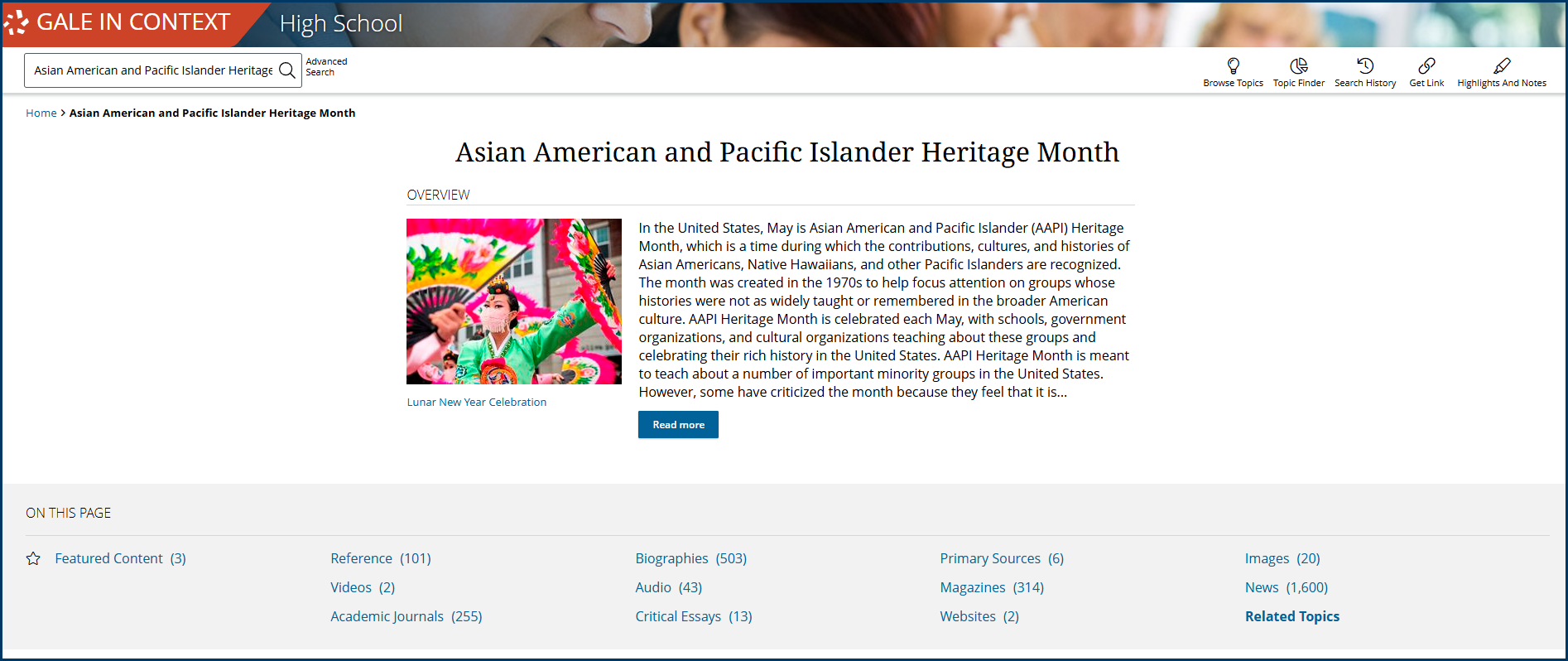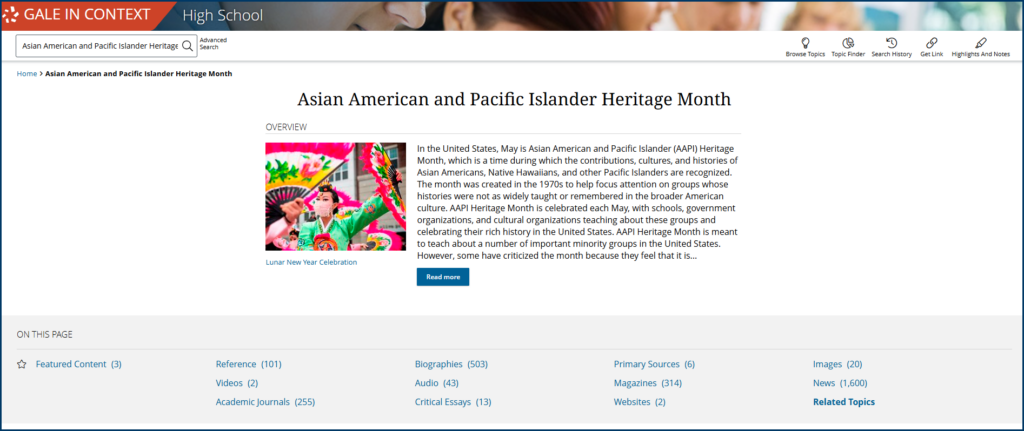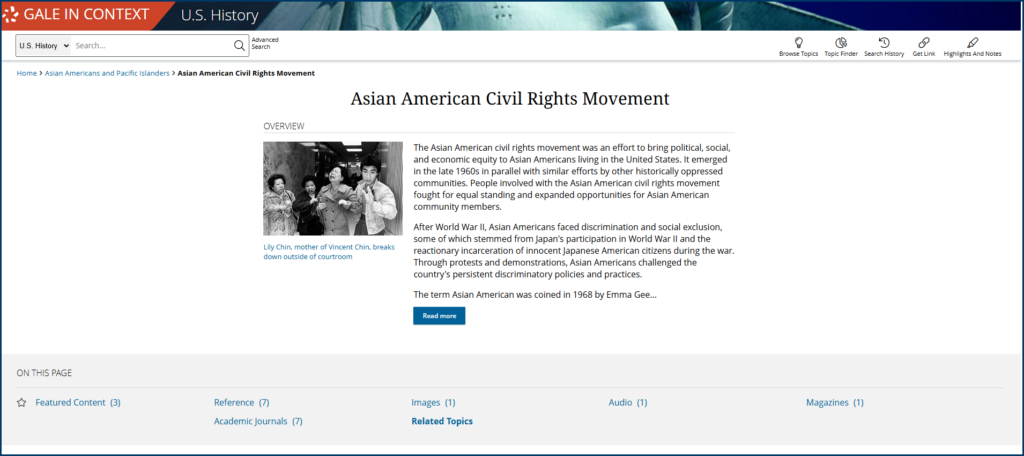| By Gale Staff |
Do your students recognize Mindy Kaling from The Office? Maybe they know Bowen Yang, the first Chinese-American comedian to star on Saturday Night Live, from his appearance in the movie Wicked. How about former presidential candidates Tulsi Gabbard, Vivek Ramaswamy, and Andrew Yang?
May is Asian American and Pacific Islander (AAPI) Heritage Month, offering the perfect opportunity to explore the contributions and stories of these and other influential entertainers, politicians, business leaders, scientists, astronauts, and more.
You can turn to Gale’s extensive academic resources for in-depth material and support. Let’s explore some of the articles, videos, audio, and other materials you can find in our Gale In Context: Biography, High School, and U.S. History databases.
Understand the Origins and Importance of AAPI Heritage Month
Asian American and Pacific Islander Heritage Month first began as a week-long observance to highlight the role of AAPI communities in U.S. history and culture. In June 1977, U.S. Representatives Norman Mineta of California and Frank Horton of New York introduced a House resolution designating the first week of May for the celebration. Daniel Inouye and Spark Matsunaga, both of Hawaii, put forth a similar bill in the Senate. In 1978, President Jimmy Carter signed a joint resolution into law, and the first observance occurred in May 1979.
In 1992, President George H. W. Bush expanded the weeklong observance into a full month. The annual celebration honors the achievements and contributions of Native Hawaiians, Asian Americans, and Pacific Islander Americans throughout U.S. history and in our society today.
In choosing May for AAPI Heritage Month, the authors of the legislation cited two critical dates—May 7, 1843, and May 10, 1869. On May 7, 1843, a 14-year-old fisherman named Manjiro became the first recorded Japanese immigrant to come to the U.S. The latter date, May 10, 1869, known as Golden Spike Day, marks the transcontinental railroad’s completion, thanks in large part to the labor of thousands of Chinese workers. These laborers toiled under brutal conditions and received less pay than white workers. Many Chinese immigrants perished during the railroad’s construction.
Recognize the Contributions of Asian Americans and Pacific Islanders
From scientific advancement to political leadership and the heights of the entertainment industry, the AAPI community’s impact is integral to our country’s identity and development. With help from Gale In Context: Biography, let’s take a look at a few key figures that you can introduce to the classroom.
Ladda Duckworth (b. 1968), more commonly known as Tammy, is a former U.S. Army National Guard pilot who was injured in Iraq in 2004. She lost both her legs during a major attack and sustained other serious injuries. In 2006, she unsuccessfully ran for representative from Illinois in the U.S. House. She ran again in 2012 and won. When Duckworth ran for the U.S. Senate in 2016, she and Kamala Harris became the second and third Asian American women elected to the legislative body. Senator Mazie Hirono from Hawaii was the first in 2012.
Jonny Kim (b. 1984), MD, is an emergency medicine physician, Harvard University graduate, and former Navy SEAL. The son of South Korean immigrants, Kim is a decorated combat veteran, having served more than 100 missions during the Iraq War. After earning his MD from Harvard Medical School in 2016, NASA accepted him to its astronaut training program in 2017. Kim is set to become the first Korean-American to serve on the International Space Station, scheduled to launch on the Roscosmos Soyuz MS-27 spacecraft in April 2025.
Chien-Shiung Wu (1912–97), PhD, was a Chinese-born physicist who made her mark in atomic science. Her work contributed significantly to improvements in radiation detection and uranium enrichment. She also participated in the top-secret Manhattan Project, as part of the Allies’ efforts to develop and deploy a nuclear weapon ahead of Nazi Germany.
Provide an Overview of AAPI History with Gale In Context
In addition to highlighting notable individual accomplishments, consider opportunities to weigh broader historical events. Gale In Context: U.S. History provides in-depth resources to bring these stories to life through articles, videos, audio, and more.
Asian Americans and the Civil Rights Movement
Most high school students are aware of the Civil Rights Movement in the United States. But do they know about the AAPI community’s participation?
The Asian American Civil Rights Movement of the late 1960s was partially a response to the internment of Japanese Americans after the attack on Pearl Harbor during World War II. Discrimination ran deep, affecting diverse communities—notably due to the Chinese Exclusion Act of 1882, which restricted immigration, and wasn’t repealed until 1943.
Inspired by the political movements of the era, the Asian American Movement arose in the late 1960s, thanks to the activism of individuals like Yuri Kochiyama. During World War II, Kochiyama’s family had been detained, along with more than a hundred thousand other Japanese Americans. Kochiyama later met Malcolm X and remained friends with him until his assassination.
In the wake of the 1982 murder of Vincent Chin, a 27-year-old Chinese-American engineer, a renewed wave of protests erupted across the U.S. condemning anti-Asian sentiments and discrimination. In 1988, President Ronald Reagan signed the Civil Liberties Act into law, which acknowledged the injustices against Japanese Americans during World War II. The Act led to a formal apology and reparations paid to survivors and family members of those interred.
Incorporate Ready-Made Classroom Activities from Gale
In-class activities are excellent ways to apply lecture materials. We have a collection of ready-made activities that you can leverage for your classroom’s AAPI Heritage Month discussions.
For example, have students create and share country trading cards to help them learn fascinating details about Asian nations. Include key facts on each card, such as primary language(s), population and other statistics, cultural traditions, and exports.
You can also organize an in-class Jeopardy game, featuring categories such as Pop Culture, Groundbreaking Scientists, and Cuisine.
If you want to expand your activities further, you might consider these additional ideas:
- Explore the influence of K-pop music, the introduction of yoga from India to the U.S., or popular Asian and Indian dishes to highlight the infusion of AAPI culture.
- Arrange for on-site or virtual visits to AAPI exhibits at the Smithsonian Institute or the Wing Luke Museum of the Asian American Experience.
- Discuss legislative acts and policies that have shaped immigration and other aspects of life for AAPI individuals. What lessons can we learn from such detrimental policies as the Chinese Exclusion Act and the confinement of Japanese Americans during World War II?
Partner with Gale to Foster Cultural Appreciation and Inclusion
At Gale, we strive to help you enrich your students’ understanding of U.S. culture and the world around them. By tapping into our learning tools and extensive databases, you can enhance students’ cultural awareness and celebrate the contributions of the AAPI community throughout our nation’s history.
Ready to get started? Contact one of our education consultants today for more information.



